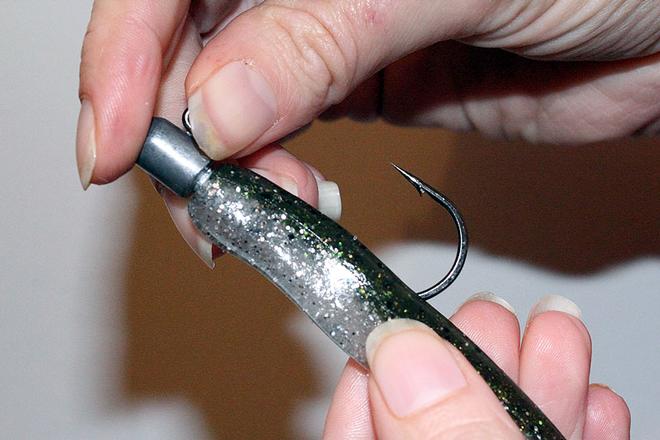How to choose and correctly rig a soft plastic
by Jarrod Day on 26 Dec 2013

step 4a Jarrod Day
Rigging a soft plastic lure is about as easy as rigging an actual bait but should you get it wrong, you’ll more than likely find it more difficult to catch quality fish.
When it comes to soft plastics and jig head selection there is a lot of factors which come into play. Firstly you need to choose a target species then choose the right softie and jig head to match both the lure and the fish being targeted.
For instance, when targeting bream you might choose a 2' grub style plastic in which you might go with a 1/20th or 1/16th ounce head with size 1 or 2 hook. The reason for such a light weight is to have the lure look as natural as possible when free falling to the bottom.
When targeting snapper, the hook size that is best suited should be either a 4/0 or 5/0 with a weight best suited to get to the bottom depending on the depth being fished. If in 8-12 meters, I’d suggest a ¼ ounce weight while in 15-20 meters I’d use a 3/0 ounce head providing there was no current. If there was current to contend with, then you might look at an ounce weight with the same size hook.
Below are a few steps on the correct manner in which to rig your soft plastic lure for better success.
Step 1 – firstly, take the appropriate jig head and soft plastic and lay the jig head along side of the plastics body to measure where the hook will penetrate through the body.
Step 2 – leaving your thumb and forefinger in the position of where the hook will push through the plastics body, take the jig head and enter the hooks point in the center of the nose.
Step 3 – push the hooks point into the plastic and thread the body of the plastic along the shank of the hook to the neck of the jig head.
Step 4 – push the hooks point through the back of the plastic to it pushes right through and force the head of the plastic over the neck of the jig head so it butts up against the main body of the head.
Step 5 – check to see if the plastic is straight on the jig head, if not repeat the process until it is.
The purpose of having the plastic rigged straight is to get the desired action from the lure when retrieved in the water. If the plastic is rigged off center or incorrectly, the action of the lure will not be as appealing and act different to that of a fleeing baitfish or dying one.
Regardless of species being targeted, rigging your soft plastics the correct way will give you the best chance at success. Rig it right and you’ll catch a much better class of fish.
If you want to link to this article then please use this URL: www.sail-world.com/117893